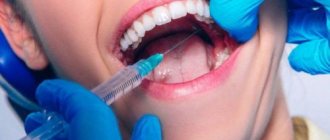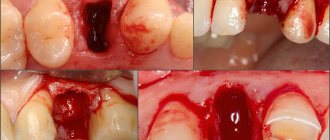Every second person who experiences toothache does not decide to seek help from a dentist in a timely manner. And the reason for this is the elementary fear of painful sensations during treatment procedures. The issue of pain relief is acute and relevant for modern dentistry. Let's look at common painkillers that are used in dental treatment and can help get rid of the phobia of pain experienced during dental procedures.
Relatively recently, the use of anesthetics to reduce pain during dental treatment has become a standard part of the procedure. Anesthesia is a complete or partial loss of sensation in a certain area of the body or in certain parts of it. As a rule, this effect is achieved by administering to the patient an individually calculated amount of medications that block the flow of pain signals from the area of dental intervention to the brain.
In dentistry, anesthesia is used directly during therapeutic or surgical procedures. The dentist does a tremendous amount of work in a short period of time, while causing minimal harm to the human body.
The need for pain relief during dental treatment
There are several times more nerve endings in tooth tissue than are located on human skin. The dental nerve has high sensitivity and conduction of pain sensations. Therefore, toothache is the most severe of all. When performing dental treatment, the dentist must correctly administer anesthesia, otherwise the patient will not avoid suffering.
Feeling pain, the patient may involuntarily make a sudden movement, which will cause breakage of the instrument or damage to the oral cavity. Some patients, unable to overcome the fear of injection, want to do without anesthesia. This is wrong: the body can react unpredictably to toothache. Firstly, pain raises adrenaline in the body, which provokes a rapid heartbeat. Secondly, blood pressure and blood sugar immediately increase.
It is safe to say that in dentistry, anesthesia is necessary to prevent the deterioration of a person’s general condition.
Side effects
Nausea is a common side effect of general anesthesia.
There are a number of potential side effects of anesthesia.
Some people may experience none, others several. None of the side effects are particularly long-lasting and usually occur immediately after anesthesia.
Side effects of general anesthesia include:
- temporary confusion and memory loss, although this is more common in older people
- dizziness
- difficulty urinating
- bruising or soreness from the IV
- nausea and vomiting
- trembling and chills
- sore throat due to breathing tube
Recommendations for the use of anesthesia in dentistry
Anesthesia is necessary when performing the following dental procedures:
- therapy in the treatment of deep caries, as it affects the deep layers of dentin;
- removal of the nerve (depulpation) is a frequent operation, especially in cases of advanced caries;
- tooth extraction surgery;
- any surgical manipulations in the oral cavity - suturing, removal of formations;
- preparing the tooth for the process of prosthetics or implantation.
Medicines with an analgesic effect are also used to eliminate medium-sized caries.
Restrictions on the use of painkillers
Before carrying out any interventions or administering anesthesia to the patient, the attending physician must conduct a conversation during which he learns about the presence or absence of pathologies:
- chronic heart disease;
- a stroke suffered by the patient within six months;
- allergies to certain medications;
- diabetes.
It is necessary to take into account every possible disease from the above list in order to avoid unwanted complications.
Particular attention is paid to young patients. Treatment of children's teeth without anesthesia is impossible, so moral preparation is important. An experienced doctor will be able to find an approach to the child, not frighten him with a syringe and a needle, but administer anesthesia as painlessly and delicately as possible for the child’s fragile psyche. If the child is very impressionable or is not sufficiently aware of what will be done to him, the use of sedatives and sedatives is quite justified.
Rules to follow
To achieve the maximum effect from the use of anesthesia and avoid serious negative consequences during this process, the patient should follow the following simple recommendations before dental procedures:
- Women should not plan to visit the dentist during menstruation.
- The day before the treatment procedure, the patient should refrain from drinking alcoholic beverages. The combination of alcohol and medications in the body can have a negative effect on human health.
- If you feel unwell, especially related to the nasopharynx, then it is better to reschedule previously planned dental procedures. Difficulty in nasal breathing and swelling of the throat are the first signs of infection, and manipulations in the oral cavity will aggravate the situation.
ZAKS
The use of nitrous oxide (or laughing gas) is an ancient (used since 1844) and very effective method of pain relief, which has been adopted by the most modern clinics. Inhaling small amounts of nitrous oxide mixed with oxygen causes mild euphoria and has a relaxing and pain-relieving effect (called sedation). Nitrous oxide sedation is absolutely harmless, acts almost instantly, and recovery from it takes 10–15 minutes without any consequences.
Indications:
- fear and anxiety before treatment;
- young age of patients (most often ZAX is used for children);
- long-term treatment (for example, many teeth are removed at once);
- pronounced gag reflex, profuse salivation.
Contraindications:
- age under 3 years;
- severe intoxication, chronic alcoholism;
- mental disorders, severe neurological diseases;
- sensitivity to individual components of the mixture;
- very strong excitement before upcoming dental procedures, hyperexcitability or hysteria (in children);
- 1st trimester of pregnancy;
- use ZAX with extreme caution in case of high blood pressure, previous concussion and other head injuries;
- Serious respiratory tract infections (asthma, bronchitis) may be a contraindication to sedation.
ZAX does not exclude the use of conventional anesthetics. There is no need to prepare for ZAX in any specific way, but 2 hours before the procedure it is highly advisable to refuse any food (you can drink). On the day of sedation, it is better to take a day off from work and not drive. Children are advised to refrain from active games for 1-2 hours after sedation.
Types of pain relief in the dental office
Anesthesia can be general or local. There is also a distinction between medicinal and non-medicinal anesthesia. The last method of pain relief is rarely used, it includes:
- Electroanalgesia. Direct electric current or electrophoresis with anesthetics such as Novocaine or Trimecaine is used.
- Audio analgesia. Sound anesthesia, which involves the use of quiet music and monotonous sounds to calm the patient.
- A method of computer anesthesia that allows you to administer an anesthetic under computer control. The possibility of overdose and the occurrence of unpleasant sensations during the injection procedure is completely excluded.
Drug anesthesia is based on the administration of an individually selected anesthetic. The entry of pain signals into the cerebral cortex is completely blocked. Due to this, sensitivity in the area of the body that is amenable to intervention is lost for the required period of time. After completion of the surgical intervention, the drug is independently removed from the tissues and sensitivity returns.
This anesthesia is considered one of the most common and allows you to protect the patient from pain during dental procedures. General anesthesia is rarely used. The exception is cases when it is necessary to carry out a large number of different procedures, taking into account the patient’s intolerance to certain components of anesthetics for local use. Such anesthesia is permitted for use in dental treatment in children over four years of age or during maxillofacial operations.
Story
General anesthetics have been widely used in surgery since 1842, when Crawford Long prescribed diethyl ether to a patient and performed the first painless operation.
On October 16, 1846, American dentist and surgeon Thomas Morton first administered ether anesthesia to a patient to remove a submandibular tumor.
In Russia, the first operation under anesthesia was performed on February 7, 1847 by Pirogov’s friend at the professorial institute, Fyodor Inozemtsev.
Pirogov himself performed the operation using anesthesia a week later. Over the course of a year, 690 operations were performed under anesthesia in 13 cities of Russia, 300 of which were performed by Pirogov!
Soon he took part in military operations in the Caucasus. Here, for the first time in the history of medicine, he began to operate on the wounded with ether anesthesia. In total, the great surgeon performed about 10,000 operations under ether anesthesia.
Local anesthesia in dentistry: types, advantages and disadvantages
In many standard situations, treatment or complete tooth extraction is carried out using local anesthesia. Thanks to this method of anesthesia, dentists can eliminate pain. However, after the administration of an anesthetic, sensitivity is not completely lost: the patient feels a touch, which causes discomfort. To minimize this kind of inconvenience, the patient is prescribed sedatives on the eve of the procedure. Common local anesthetics used in a huge number of clinics: Novocaine and Lidocaine.
In the medical practice of modern dental science, more effective medications are also used. Dentists identify six methods of local anesthesia, based on the scope of application and methods of administering the drug:
- Application anesthesia is intended for superficial anesthesia. The dentist sprays the spray onto the desired area in the mouth. It is possible to treat part of the mucous membrane with an ointment containing an anesthetic. This manipulation is carried out by the doctor right before the start of the procedure. The main component of this product is Lidocaine (10%) in aerosol cans. Application anesthesia is practiced when grinding a tooth before prosthetics or when there is reduced sensitivity of soft tissues. Such anesthesia is also used for stomatitis, gingivitis and the need to open minor suppurations.
- If work is being done on one tooth and only that tooth needs to be numbed, the dentist uses infiltration anesthesia. With its help, one tooth and a small part of the mucous membrane near it are deprived of sensitivity. This is how deep caries is treated and the nerve bundle is removed. The injection is administered into the protective area of the upper part of the tooth. It blocks the passage of a signal from the area of irritation. This method is used when treating teeth on the upper jaw: it is thinner than the lower jaw and the anesthetic penetrates more easily to the nerve endings.
- Conductor. Designed to relieve pain in two adjacent teeth. Or when infiltration anesthesia does not properly numb the desired area. Conduction anesthesia is effective for tooth extraction, opening abscesses, exacerbation of chronic periodontitis and cleansing the cavity from purulent foci.
- Intraligamentary anesthesia is used in dentistry for children: they provide pain relief during the treatment of caries and its possible complications. The mucous membrane remains sensitive so that the child does not involuntarily bite his tongue, cheek or lips.
- Tooth extraction is accompanied by intraosseous anesthesia: the effect is lightning fast, but not long lasting. The dentist makes an injection into the gum; the anesthetic drug blocks the sensitivity in a certain tooth. Local numbness occurs, after which the dentist makes a second injection into the lip from the inside.
- Stem anesthesia is used in situations where the degree of pain experienced by the patient is high, with neuralgia, with significant injuries to the jaws or cheekbones, when surgical intervention cannot be avoided. The nerves are blocked simultaneously in both jaws. The use of such anesthesia is more effective and lasts longer.
Complications
The most common complications after local anesthesia:
- soft tissue injury - while the anesthetic is still in effect, you need to be careful not to accidentally bite your lip, cheek, or tongue;
- bruise - hematomas occur if the needle touches a vessel during an injection.
Other complications include spasms of the masticatory muscles (when injured by a needle), allergies to painkillers, and temporary loss of sensitivity in the facial muscles. Even less often, the needle breaks off, and in isolated cases, infection occurs.
It is worth noting that complications from local anesthesia are extremely rare. This is the safest and simplest type of pain relief.
But complications from general anesthesia occur more often:
- nausea;
- vomit;
- fainting, collapse;
- inappropriate behavior.
The most dangerous consequences are disruption of respiratory and cardiac activity, which can result in death without resuscitation measures.
Medicines used in dentistry for pain relief
Many dentists prefer to work with drugs from the articaine series. The choice is justified by their effectiveness and an order of magnitude higher quality than Lidocaine and Novocaine. The main advantage of such painkillers is their direct effect on areas of inflammation. Painkillers often contain adrenaline and epinephrine. Under their influence, vasoconstriction occurs, increasing the strength of the drug.
The most common anesthetics:
- Ultracaine is a medical analgesic drug originally from France, which is produced in three modifications. The difference is based on the concentration of epiniphrine and its concentration in the drug. The absence of such a component, which has a vasodilating effect, affects the duration of pain relief: it reduces it by 20 minutes. The anesthetic can be administered to children over 4 years of age and pregnant women. A separate form of the drug has its own list of contraindications.
- The composition of the anesthetic Ubistezin is similar to Ultracaine. It is developed and produced in two forms, the difference between which is the different concentration of epinephron. On average, it lasts for 30-40 minutes. Designed for patients suffering from heart disease and patients with high blood pressure. Used for standard procedures: tooth extraction and treatment.
- The anesthetic Septanest contains articaine and adrenaline with a small amount of preservatives. It is allowed to be used by pregnant women, during the lactation period, and children over 4 years old. Allergy sufferers should not use this pain reliever. The effect of the drug lasts no more than five minutes.
Types
There are three main types of anesthesia . General anesthesia is just one of them.
Local anesthesia is another option. It is done before minor surgeries such as toenail removal. This reduces pain in small, focused areas of the body, but the person receiving treatment remains conscious.
Regional anesthesia is another type. It numbs the entire part of the body - the lower half, for example, during childbirth. There are two main forms of regional anesthesia: spinal anesthesia and epidural anesthesia.
Spinal anesthesia is used for operations on the lower extremities and abdomen. The anesthetic is injected through a special very thin needle into the intervertebral space of the lumbar region . Epidural anesthesia is used for long-term pain relief. Can be used for operations on the chest, abdomen, and lower extremities. During an epidural, a thin plastic catheter is inserted through which a local anesthetic is injected. Pain relief can last as long as needed.











